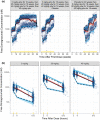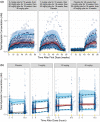Population PK and PD Analysis of Domagrozumab in Pediatric Patients with Duchenne Muscular Dystrophy
- PMID: 36104012
- PMCID: PMC9828399
- DOI: 10.1002/cpt.2747
Population PK and PD Analysis of Domagrozumab in Pediatric Patients with Duchenne Muscular Dystrophy
Abstract
Myostatin, a negative regulator of skeletal muscle growth, is a therapeutic target in muscle-wasting diseases. Domagrozumab, a humanized recombinant monoclonal antibody, binds myostatin and inhibits activity. Domagrozumab was investigated in a phase II trial (NCT02310763) as a potential treatment for boys with Duchenne muscular dystrophy (DMD). Pharmacokinetic/pharmacodynamic (PK/PD) modeling is vital in clinical trial design, particularly for determining dosing regimens in pediatric populations. This analysis sought to establish the PK/PD relationship between free domagrozumab and total myostatin concentrations in pediatric patients with DMD using a prior semimechanistic model developed from a phase I study in healthy adult volunteers (NCT01616277) and following inclusion of phase II data. The refined model was developed using a multiple-step approach comprising structural, random effects, and covariate model development; assessment of model adequacy (goodness-of-fit); and predictive performance. Differences in PKs/PDs between healthy adult volunteers and pediatric patients with DMD were quantitatively accounted for and evaluated by predicting myostatin coverage (the percentage of myostatin bound by domagrozumab). The final model parameter estimates and semimechanistic target-mediated drug disposition structure sufficiently described both domagrozumab and myostatin concentrations in pediatric patients with DMD, and most population parameters were comparable with the prior model (in healthy adult volunteers). Predicted myostatin coverage for phase II patients with DMD was consistently > 90%. Baseline serum myostatin was ~ 65% lower than in healthy adult volunteers. This study provides insights into the regulation of myostatin in healthy adults and pediatric patients with DMD. Clinicaltrials.gov identifiers: NCT01616277 and NCT02310763.
© 2022 Pfizer Inc. Clinical Pharmacology & Therapeutics published by Wiley Periodicals LLC on behalf of American Society for Clinical Pharmacology and Therapeutics.
Conflict of interest statement
B.T., P.D., and L.O.H. were employees of and hold stock in Pfizer; V.S.P., T.N., and J.W. are employees of and hold stock in Pfizer.
Figures





References
-
- Mendell, J.R. & Lloyd‐Puryear, M. Report of MDA muscle disease symposium on newborn screening for Duchenne muscular dystrophy. Muscle Nerve 48, 21–26 (2013). - PubMed
-
- Werneck, L.C. , Lorenzoni, P.J. , Ducci, R.D. , Fustes, O.H. , Kay, C.S.K. & Scola, R.H. Duchenne muscular dystrophy: an historical treatment review. Arq. Neuropsiquiatr. 77, 579–589 (2019). - PubMed
-
- McNally, E.M. Powerful genes‐myostatin regulation of human muscle mass. N. Engl. J. Med. 350, 2642–2644 (2004). - PubMed
Publication types
MeSH terms
Substances
Associated data
LinkOut - more resources
Full Text Sources
Medical
Miscellaneous

